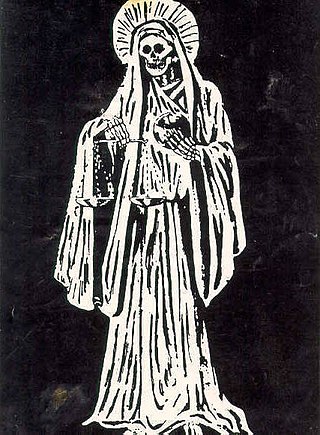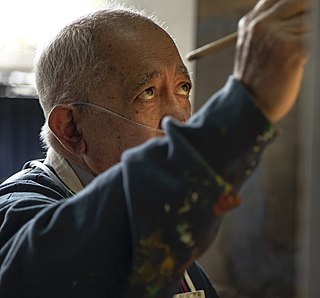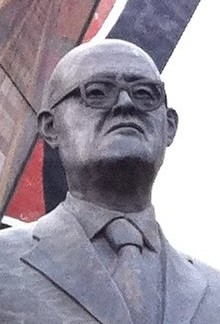
David Alfaro Siqueiros was a Mexican social realist painter, best known for his large public murals using the latest in equipment, materials and technique. Along with Diego Rivera and José Clemente Orozco, he was one of the most famous of the "Mexican muralists".

The Polyforum Cultural Siqueiros is a cultural, political and social facility located in Mexico City as part of the World Trade Center Mexico City. It was designed and decorated by David Alfaro Siqueiros in the 1960s and hosts the largest mural work in the world called La Marcha de la Humanidad. The building has a theatre, galleries and more, but the main focus is the Forum Universal, which contains the interior portion of Siqueiros' mural work. Visitors can experience the mural while standing on a rotating stage, listening to Siqueiros narrate.
Rodolfo Nieto Labastida was a Mexican painter of the Oaxacan School.

Skull art is found in various cultures of the world.

Mexican muralism refers to the art project initially funded by the Mexican government in the immediate wake of the Mexican Revolution (1910–1920) to depict visions of Mexico's past, present, and future, transforming the walls of many public buildings into didactic scenes designed to reshape Mexicans' understanding of the nation's history. The murals, large artworks painted onto the walls themselves had social, political, and historical messages. Beginning in the 1920s, the muralist project was headed by a group of artists known as "The Big Three" or "The Three Greats". This group was composed of Diego Rivera, José Clemente Orozco and David Alfaro Siqueiros. Although not as prominent as the Big Three, women also created murals in Mexico. From the 1920s to the 1970s, murals with nationalistic, social and political messages were created in many public settings such as chapels, schools, government buildings, and much more. The popularity of the Mexican muralist project started a tradition which continues to this day in Mexico; a tradition that has had a significant impact in other parts of the Americas, including the United States, where it served as inspiration for the Chicano art movement.
Santos Balmori Picazo was a Spanish-Mexican painter whose heavily European style was not appreciated by his contemporaries of the Mexican muralism movement, but he had influence with the succeeding Generación de la Ruptura artists. He trained and began his art career in Europe moving later to Mexico City. He became a professor and researcher at the Escuela Nacional de Artes Plásticas training younger artists such as Rodolfo Nieto, Pedro Coronel, Carlos Olachea and Juan Soriano. As a teacher, he did not stop drawing but he did not paint professionally again until after retirement, having a number of exhibitions later in life.

Luis Arenal Bastar was a Mexican painter, engraver and sculptor. He was a founding member of the Liga de Escritores y Artistas Revolucionarios, the Taller de Gráfica Popular and the Salón de la Plástica Mexicana. In addition, he created murals and other monumental works in Mexico City and Guerrero.

Gilberto Aceves Navarro was a Mexican painter and sculptor and a professor at the Escuela Nacional de Artes Plásticas and Academy of San Carlos. There have been more than two hundred individual exhibits of his work, with his murals found in Mexico, Japan and the United States. He received numerous awards for his work including grants as a Creador Artístico of the Sistema Nacional de Creadores de Arte, Premio Nacional de Ciencias y Artes and Bellas Artes Medal from the Instituto Nacional de Bellas Artes.
Sofía Bassi was a Mexican painter and writer noted for her surrealist work as well as her personal life, which included five years in prison for murder. She maintained an active career despite incarceration, painting her first mural in prison in Acapulco, with the assistance of Alberto Gironella, José Luis Cuevas, Rafael Coronel and Francisco Corzas. This mural can now be found at the municipal building of the city.
Mario Orozco Rivera was a Mexican muralist and painter, a later proponent of Mexican muralism, and whose work was particularly influenced by David Alfaro Siqueiros. He created a number of murals, mostly in the state of Veracruz before becoming an assistant to Siqueiros, directing the Taller Siqueiros in Cuernavaca and working with the artists on projects such as the Polyforum Cultural Siqueiros. While preferring mural work, which he considered less commercial, Orozco Rivera also created oils and sculptures. Many of these works were exhibited in Mexico and abroad and can be found in many major collections. His work received recognition in various countries.

Colonia Nápoles is a colonia in Benito Juárez, Mexico City in the North central area of the metropolis. Along with Colonia Del Valle, it's among the most representative of Mid-Century neighborhoods of Mexico City.
Sebastián Canovas Ávalos is a Mexican artist known for watercolors, oil paintings and murals. He has exhibited throughout Mexico, in the United States, Canada, Switzerland, Germany and France.
Laura Elenes (1933–2005) was a Mexican painter, sculptor and print maker. whose work was recognized with membership in the Salón de la Plástica Mexicana and several tributes in Mexico and other countries after her death.
Consuelo González Salazar is a Mexican painter whose work has been recognized with membership in the country’s Salón de la Plástica Mexicana.
Elena Huerta Múzquiz, also known as Elena Huerta de Arenal was a Mexican artist, she was best known for her mural work in her hometown of Saltillo, Coahuila, Mexico. Most of her art career was dedicated to teaching, but she was one of the founders of the Compañía de Teatro Infantil with German Cueto, Lola Cueto, Angelina Beloff and Leopoldo Méndez, the Liga de Escritores y Artistas Revolucionarios and a founding member of the Salón de la Plástica Mexicana.
Arturo Moyers Villena was a Mexican muralist and painter, whose work was influenced by David Alfaro Siqueiros. Many of his mural works are exhibited in government buildings or cultural institutions.

Manuel Suárez y Suárez was a Spanish immigrant to Mexico who became a successful entrepreneur and patron of the arts. He is known for the Casino de la Selva in Cuernavaca, the Hotel de México, and the adjacent Polyforum Cultural Siqueiros.

Susana Noriega Rivero is a Mexican avant-garde painter, whose work is located in the abstract expressionist and surrealist movements.
Electa Arenal, born as Elena Electa Arenal y Huerta, was a Mexican artist, known best as a muralist painter, and sculptor.










